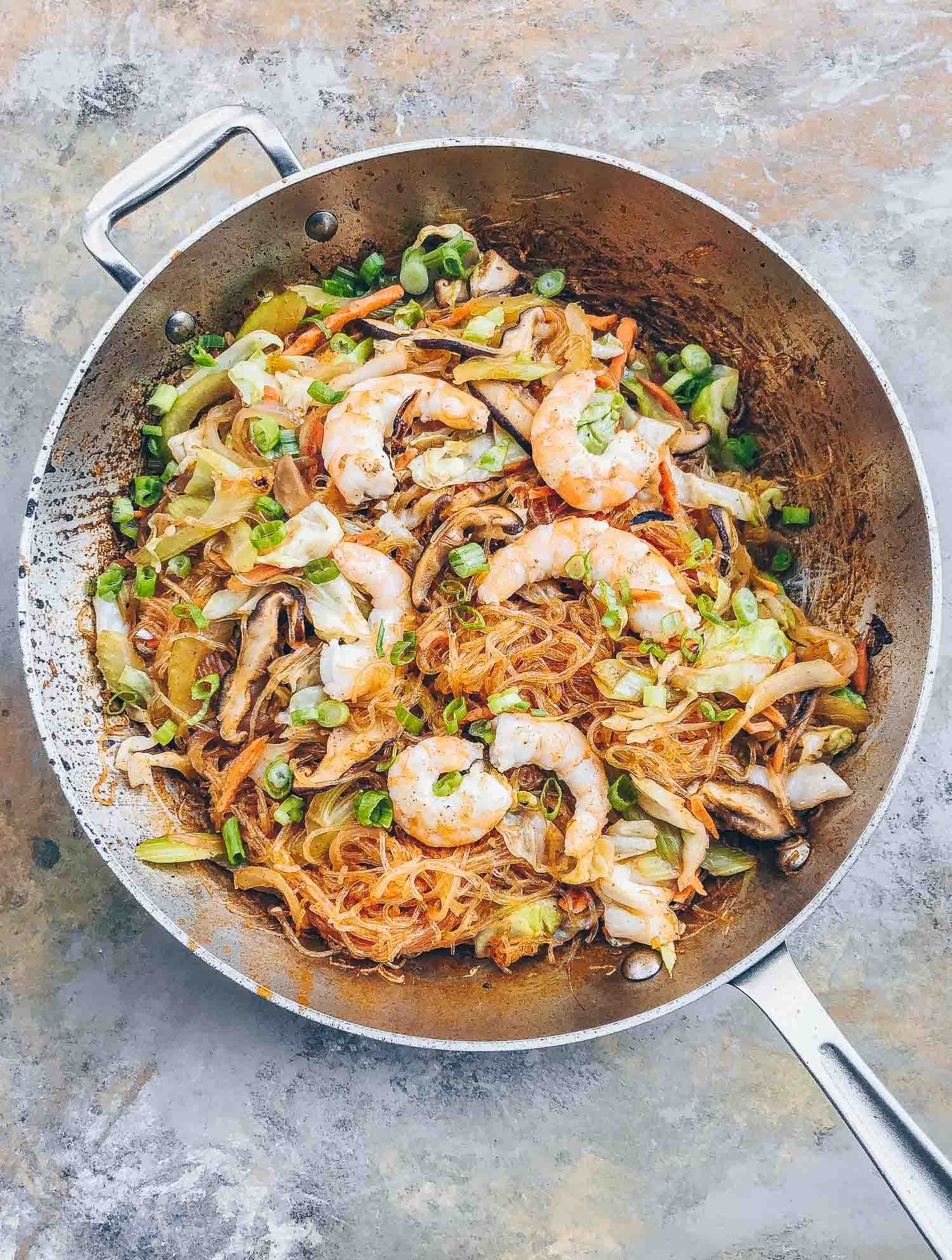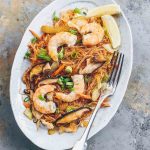Sotanghon Guisado: Stir-Fried Glass Noodles
This popular stir-fried dish from the Philippines uses glass noodles (cellophane noodles, bean thread noodles) as the feature ingredient. They have a wonderfully chewy, springy texture and absorb the flavors of the stir-fry quite well.

With a few other pancit recipes (Filipino noodles) on the blog already I haven’t been in a hurry to share this, another classic, made with sotanghon, or glass noodles. But as I’m wont to take snapshots of my meals (and my succulents, too, for that matter), serving only to add to the photo clutter in my phone, I realized later, why not put these impromptu pictures to use and share the recipe now?
You may have heard of or have even tasted pancit guisado or pancit bihon, perhaps the most recognizable pancit (noodle) dish to non-Filipinos (my recipe is here) but there could be as many regional varieties of pancit (pahn-sit) as maybe Imelda had shoes.

What is Sotanghon?
Where the more popular pancit bihon (bee-hon) is made with rice noodles, sotanghon (so-tahng-hon) is made with glass noodles (or cellophane noodles or bean thread noodles). They are thin and translucent, often made with mung bean starch with a chewy, springy texture when cooked. For those with dietary concerns, since glass noodles are not made with wheat flour they are gluten free. I like them not just for their texture but also for how well they absorb the flavors they’re cooked in.
Sotanghon noodles are used throughout East and South East Asia and besides the alternate names I’ve mentioned above you might find them sold also as vermicelli noodles. It can be confusing at first, I admit, particularly when you visit the noodle aisle at your local Asian grocery store. Thankfully, most varieties of Asian noodles are now available at most markets.
Look for dry, thin noodles that look wiry. They’re typically packaged in pink plastic mesh bags and though the noodles are long, they’re dried in little three-inch, two-ounce bundles. Some rice noodles may look similar so be sure to check the ingredient list and look for mung bean starch (or potato starch or pea starch) as the main ingredient.
Pancit Sotanghon Ingredients
Carrots, green beans, green cabbage, onion and garlic are the usual accompaniments to sotanghon noodles. Wood ear mushrooms are also a traditional ingredient–for me, they’re more for adding a crunchy texture rather than flavor so I don’t bother with them. Instead of green beans I use celery for convenience since I always have them in my crisper drawer. For protein, chicken and shrimp are most traditional but pork or tofu would work well, too. Fish sauce is more popular as the salt component but I used soy sauce here for convenience for those who may not keep fish sauce in their pantry. The results are equally delicious. Lastly, sotanghon is usually colored with annatto oil to add to its appeal. I used annatto powder in this recipe but don’t go out of your way to pick it up at the market.
Sotanghon Guisado Cooking Tips
Like pancit bihon, sotanghon guisado is a simple stir-fry and like bihon noodles, sotanghon noodles don’t need to be boiled but they need to be soaked before you can use them.
Tip 1: Pre-soak the Noodles. As I mentioned earlier, sotanghon noodles are typically sold in bundles. Soaking them in room temperature water for a few minutes softens them enough to make them pliable and easier to use during the final stages of preparing the stir-fry. You don’t want to soak them for longer than a few minutes at this stage because these noodles are highly absorbent and we need to infuse flavor into them to make them better. Once they’re pliable you can snip them in half to make tossing them with the other ingredients much easier.
Tip 2: Use Broth Rather than Water to Continue to Cook the Sotanghon Noodles. The first soak is to soften the noodles to make them easier to use. When the vegetables and protein have been stir fried, the next step is to use liquid to continue to cook them and also to add more flavor. Store-bought low-sodium stock or broth works well but if you have homemade, even better.
It takes just a few minutes for the thin noodles to plump up, turn glassy and they’re ready to enjoy. Another great thing about them is that as delicate as they look, they hold up pretty well to stir-frying and keep their texture so leftovers are usually just as good as the first day you eat them. Just make sure you have lemon wedges and ground pepper to season your plate of noodles and if you’re feeling fancy, try sliced hard-boiled eggs, scallions and even crushed chicharron (pork rinds).
Here are my other Pancit Recipes for you to try:


Sotanghon Guisado: Stir-Fried Glass Noodles
Another classic Filipino noodle dish, this version uses glass noodles which have a wonderfully springy, chewy texture that also absorbs the flavors of the dish very well.
Ingredients
- 8 ounces glass noodles (cellophane noodles, bean thread noodles) NOT rice noodles
- 4-5 large shiitake mushrooms, cleaned and sliced
- 12 medium shrimp, peeled and deveined
- 2 cloves garlic, minced
- 1/2 onion, sliced
- 2 carrots, julienned
- 3 ribs celery, sliced diagonally you can use green beans (the traditional ingredient instead of celery)
- 2-3 cups sliced green cabbage
- 1-2 tablespoons soy sauce (or fish sauce)
- 2 cups chicken stock
- 1/4 – 1/2 teaspoon annatto powder (for color; optional)
- Few tablespoons olive oil or vegetable oil
Garnish (optional)
- lemon juice
- soy sauce or fish sauce
- ground pepper
- hard boiled eggs
- scallions
Instructions
-
Soak the noodles for five minutes in a bowl with room temparature water. Drain and set aside. This makes them pliable but not ready to serve. If you wish, you can cut the noodles in half to make them easier to stir into the stir-fried vegetables.
-
Heat one to two tablespoons of olive oil in a large pan. Add the shiitake mushrooms and season lightly with salt and pepper. Cook on medium heat until each side is golden, about five minutes. Remove from pan and set aside.
-
In the same pan, add another tablespoo of oil and cook the shrimp, just until they turn opaque on both sides. Lightly season with salt and pepper while they cook. Remove from pan and set aside.
-
Add two tablespoons of oil to the same pan and turn the heat to medium-high. Add the onion, celery and carrots and cook until the vegetables celery and carrots are crisp-tender and/or beginning to caramelize. Sweep the vegetables to one side of the pan and add the minced garlic, cooking until they're fragrant, about one minute. Stir into the rest of the vegetables then add the cabbage, a few tablespoons of chicken stock and one tablespoon of soy sauce (or fish sauce). Stir together for one or two minutes, just until the cabbage begins to wilt. Taste the vegetables. It might seem overseasoned with just one tablespoon of soy sauce but you still have the noodles to stir into. I would wait to add the final tablespoon soy sauce or fish sauce until you've added the noodles. Transfer the vegetables to a large bowl and set aside.
-
In the same pan, add the two cups chicken stock and annato powder if you're using it and bring to a low boil. Add the drained glass noodles and lower the heat to medium or medium-low. The noodles will take about five minutes to absorb all the stock. When the stock has been almost completely absorbed stir the vegetables, shiitake mushrooms and shrimp into the noodles. You may need tongs or two spatulas for this. Keep the heat at medium or medium low. Taste and add the last tablespoon of soy sauce or fish sauce according to your taste.
-
Transfer to a platter or on individual plates and garnish with lemon juice, fish sauce or sauce and freshly ground pepper.










Great photos. Now I’m hungry. Great recipe. Can’t wait to make it!!!
Thank you so much, Mimi!!
My father-in-law was from the Philippines. He was the best cook and he cooked glass noodles a lot. That was such a treat. Sometimes the noodles were brown in color or red like tomato color. I have been wanting that taste again for over 40 years. He cooked a lot with pork. Please tell me where to get some recipes. Please !!!